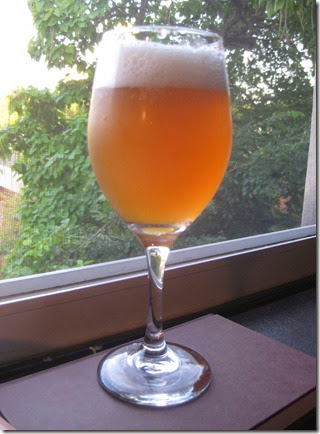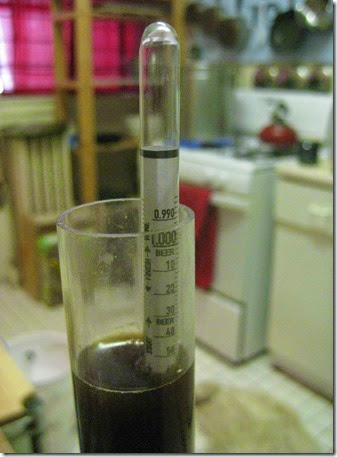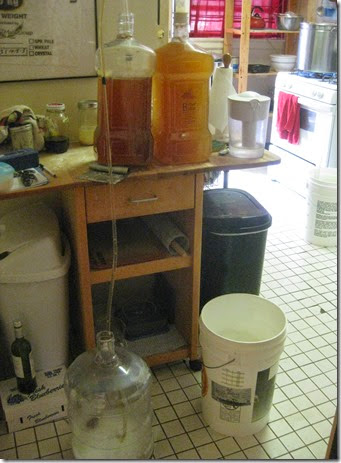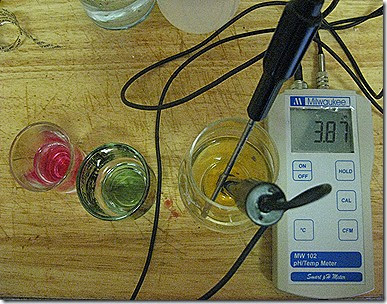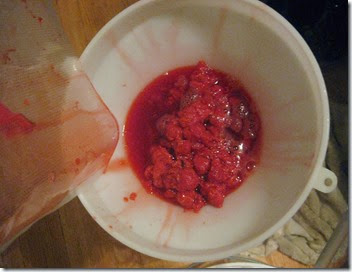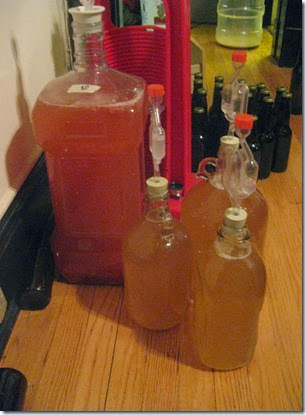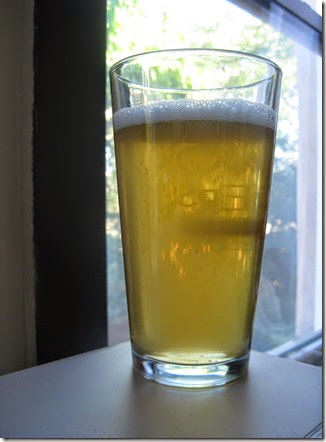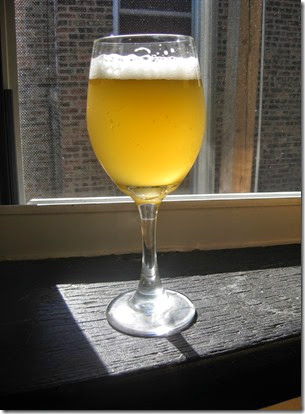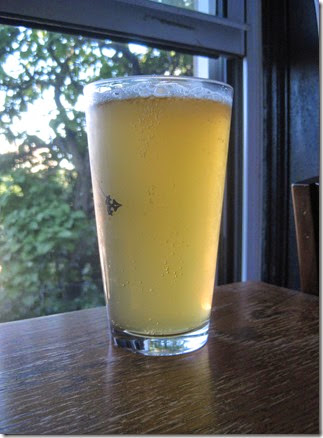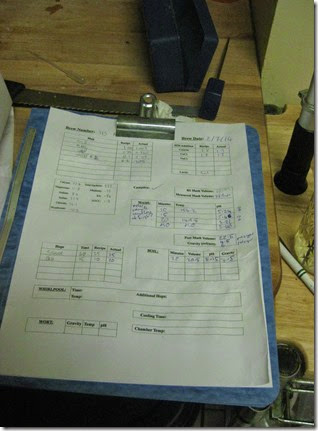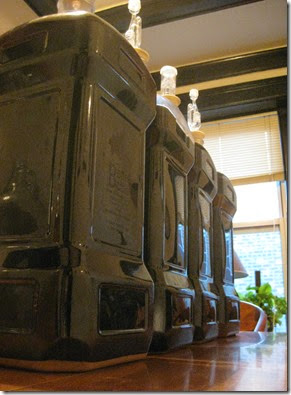 This is another post about biere de coupage, or cutting young beers with older batches (see here and here). In this case, I took a sour beer and used it to inoculate three younger beers. In one instance, at ratios high enough that I was essentially creating a blend of the two beers; and in the others, with smaller proportions of old beer, so that the main goal was to perpetuate the sour culture in the new batches.
This is another post about biere de coupage, or cutting young beers with older batches (see here and here). In this case, I took a sour beer and used it to inoculate three younger beers. In one instance, at ratios high enough that I was essentially creating a blend of the two beers; and in the others, with smaller proportions of old beer, so that the main goal was to perpetuate the sour culture in the new batches.
The `old’ sour beer was an 8 month old dark saison brewed with Wyeast 3726 and inoculated in secondary with ECY20. The beer never really came into its own---it had some leathery funk, and a light to middling sourness, but was otherwise quite bland. As a result, I never got round to putting it in bottles, even though the gravity was down at 0.999.
Looking back, when I brewed it I hadn’t tasted many dark saisons (a terrible old bottle of St. Somewhere Serge is the only one I can remember), so I didn’t have much of an idea of what I wanted from such a beer. I got the idea of brewing one from the annual Dark Saisons brewed by Michael Tonsmeire, and my original plan was to follow one of his recipes, but I think I changed my mind based on the ingredients I had on hand and the fact that I wanted something a little less alcoholic. The recipe I went with was a blend of pilsner and vienna, darkened by Carafa II and Midnight Wheat, and with some Golden Naked Oats thrown in for some body. It would probably have been fine if I bottled it, perhaps developing some more funk from the brett once it was under pressure, but I was much more excited about using it as a base for cutting other beers. I’ll describe all three in this post.
Dark Saison with Zante Currants
The main event was a stronger dark saison, along the lines of this batch by Michael Tonsmeire, though my recipe was a little different. The O.G. was 1.061, and I fermented it out with WY3711 which, as usual, took it right the way down to 1.000. This beer was cut with the largest proportion of old beer: I moved the entire 3 gallon batch to a 5 gallon carboy, and then filled up the remaining space with 2 gallons of the old saison. I also added a pound and a half of dried Zante currants.
While I didn’t try blending different proportions before racking, I did a small blend at these proportions with the gravity samples from both beers, and the result was quite promising. It had a light sourness and some subtle dark fruit, along with a fairly nice mouthfeel. Since both beers are very dry, I don’t expect much in the way of an increase in acidity. The currants will add some tartness, along with more fermentable sugar; but the bugs will probably be out-competed by the remaining saccharomyces from the young saison, so won’t get a chance to produce more acid. I’m hoping the beer will develop some more leathery funk in over the next few months; my plan is to bottle it at the end of the summer, and start drinking it in the depths of winter.
Dark Sour Ale
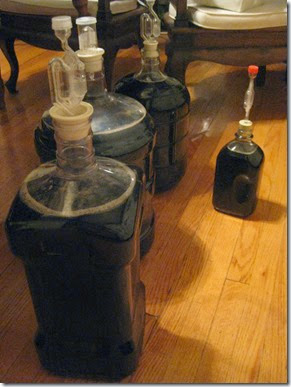 After this first blend, I had about a gallon of old sour left, and rather than blending another beer at these higher proportions I decided to use it to dose two further beers. I was inspired here by the process that Lauren and Eric Salazar implemented at New Belgium, saving the best batches of their sour beer and using them to inoculate their new barrels/batches to ensure that the most promising cultures were perpetuated. You can hear them talk about it in this interview, and there is a lot more information in American Sour Beers. In the book, Tonsmeire mentions that even now they never fully empty the foeders between batches, so that there is always around 10% of the old beer left to inoculate the new one.
After this first blend, I had about a gallon of old sour left, and rather than blending another beer at these higher proportions I decided to use it to dose two further beers. I was inspired here by the process that Lauren and Eric Salazar implemented at New Belgium, saving the best batches of their sour beer and using them to inoculate their new barrels/batches to ensure that the most promising cultures were perpetuated. You can hear them talk about it in this interview, and there is a lot more information in American Sour Beers. In the book, Tonsmeire mentions that even now they never fully empty the foeders between batches, so that there is always around 10% of the old beer left to inoculate the new one.
While this isn’t my most promising batch, it does have the full array of bugs from ECY20 in it, and since that won’t be available again for another few months this seemed like a good way to further extend the vial I bought. For the second biere de coupage, I brewed something very like Russian River’s Consecration, based on the recipe in this thread at HBT. In fact, the only real differences were that I fermented it with WY3522, and somehow missed my O.G. by about 10 points! The gravity started at 1.063, and was at around 1.009 after fermentation was complete.
To inoculate the batch, I transferred about 1.5 litres of old sour into a 3 gallon carboy, and then filled it the rest of the way with the fresh batch. I’m going to let it age for a few months before adding the Zante currants, because here I do want the bugs rather than the saccharomyces to ferment more of their sugars.
Another quick note: I reserved the excess of the young beer (~2 litres), and I am going to use it to top up these batches after refermentation of the sugars from the currants is complete. There isn’t much headspace in the carboys anyway, but since they will be conditioning in the summer heat I want to make sure there is as little oxygen as possible.
Dark Farmhouse Ale
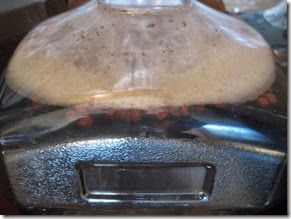 The final beer is probably the least promising of the three. Subsequent to brewing the original dark saison, I picked up a bottle of Jolly Pumpkin’s Bam Noire, and this gave me a much clearer idea of the kind of dark saison I wanted to brew: I really enjoyed its mix of dark fruit and leathery funk, and at 4.3% ABV it was right where I like my beers to be. I tried to brew a batch along the same lines to inoculate with this sour, but at such low gravity I had to add a fair bit of Carafa III (around 5%) to get the colour I wanted. As a result, the young beer tastes more like a weird schwarzbier, with lots of light roast (though nothing acrid thankfully), and nothing in the way of dark fruits, despite the Special B and Dark Crystal in the recipe. In other words, nothing like what I wanted, and to make things worse these probably aren’t flavours that will meld that well with sourness and funk.
The final beer is probably the least promising of the three. Subsequent to brewing the original dark saison, I picked up a bottle of Jolly Pumpkin’s Bam Noire, and this gave me a much clearer idea of the kind of dark saison I wanted to brew: I really enjoyed its mix of dark fruit and leathery funk, and at 4.3% ABV it was right where I like my beers to be. I tried to brew a batch along the same lines to inoculate with this sour, but at such low gravity I had to add a fair bit of Carafa III (around 5%) to get the colour I wanted. As a result, the young beer tastes more like a weird schwarzbier, with lots of light roast (though nothing acrid thankfully), and nothing in the way of dark fruits, despite the Special B and Dark Crystal in the recipe. In other words, nothing like what I wanted, and to make things worse these probably aren’t flavours that will meld that well with sourness and funk.
In hindsight, I think I tried to make the beer darker than I needed to---I was going for around 25 SRM, but I don’t think Bam Noire is actually as dark as that. When I try this again, I’ll use less Carafa III, and probably switch the Special B for an English Extra Dark Crystal.
Anyway, I decided to go ahead with the blend, adding almost all of the remaining portion of the sour beer (~3 litres) to a 3 gallon carboy, and topping it up with the young beer. My original plan had been to add a full 2 pounds of Zante currants to the dark saison described above, but after tasting them all I held back 1/2 lb to add to this one, in an effort to give it some more fruity flavours.
The gravity of this batch started at 1.039, and was at 1.006 after primary fermentation. I’m going to let it sit for a few months, and then see if I want to bottle it in the Autumn. If I don’t like the mix of roast and sour flavours, I’ll just use it in small proportions to dose another series of beers!
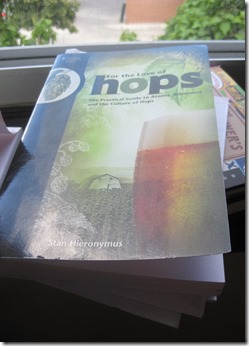 The recipe at the back of the book is called “Old World’s Mantra”, and is a sort of celebration of the old world hop varieties it employs. I brewed it directly after the Keeping Porter on Sunday (a long day!), and my notes are pretty short. I stuck to the recipe in the book as far as possible, but I was a little short of Munich malt, so I had to sub in a small portion of Vienna for some of it (I’ve copied the recipe as it is in the book below). I also didn’t have time to do the infusion mash schedule Yvan provides, but if I brew this again (and I’m sure I will) I’ll certainly follow it. The other modification of note was that I added gypsum to get my sulfate levels up to around 250ppm. This is part of an on-going investigation into how water modifications affect my bitter beers. I’ll write a post about what I’m learning in a few weeks.
The recipe at the back of the book is called “Old World’s Mantra”, and is a sort of celebration of the old world hop varieties it employs. I brewed it directly after the Keeping Porter on Sunday (a long day!), and my notes are pretty short. I stuck to the recipe in the book as far as possible, but I was a little short of Munich malt, so I had to sub in a small portion of Vienna for some of it (I’ve copied the recipe as it is in the book below). I also didn’t have time to do the infusion mash schedule Yvan provides, but if I brew this again (and I’m sure I will) I’ll certainly follow it. The other modification of note was that I added gypsum to get my sulfate levels up to around 250ppm. This is part of an on-going investigation into how water modifications affect my bitter beers. I’ll write a post about what I’m learning in a few weeks.
